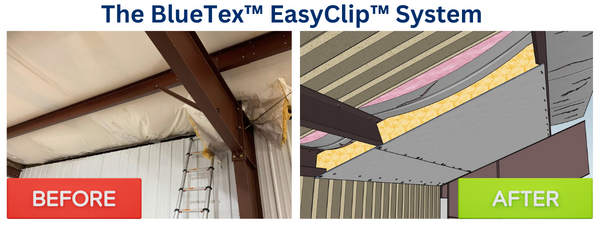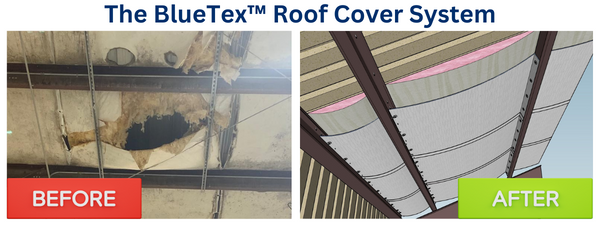The BlueTex™ EasyClip™ System and The Roof Cover System for Repairing Old Insulation
If you have a building with old insulation up in the roofline and you're looking for a way to cover it up or repair it without starting all the way over, we have two great options for achieving this.
Two Systems to Cover Old Insulation on the Roofline
The BlueTex™ EasyClip™ system uses custom designed, injection molded, polypropylene clips with protruding pins that fit snugly onto the bottom of a C-purlin or a Z-purlin along the roofline. The BlueTex™ insulation is then "stabbed" onto the bottom of the pin and a washer is added to secure the BlueTex™ permanently onto the pin/clip.

The BlueTex™ Roof Cover System that uses metal screws and locking washers to secure the BlueTex™ directly onto the metal purlins.

Below we will cover the Pros and Cons of each system so you can decide which approach is best for your application.
The Pros
The EasyClip™ System Pros:
- Hides rusty, dirty metal purlins by creating a new interior finish across the roof.
- A dead air space between BlueTex™ and the roof adds additional r-value.
- Save energy and improve comfort!
- Foil side is a radiant barrier, reflect 97% of radiant heat and create an instant shade effect.
- Get better condensation control on the bottom of the purlins - no more dripping!
- This install method can easily be modified for wood framing.
- Gain the ability to MAXIMIZE additional insulation (r-value) between the BlueTex™ layer and the old insulation.
- This is the best way to convert a bare metal roof from a “non-conditioned” to “conditioned” building.
The Roof Cover System Pros:
- Easy to handle smaller pieces of insulation
- Great for smaller damaged areas
- Perfect for “patch” jobs
- Blends in with the old insulation
- Installed above lights, conduit, sprinkler systems, etc.
- Can easily be applied to a wood roof
The Cons
The EasyClip™ System Cons:
- Works best for doing full roof area (not as good for smaller areas).
- You may need to work around lights, conduit, sprinkler systems, skylights, etc., since you're attaching the product to the bottom of the purlins.
- This method involves handling longer pieces at a time.
The Roof Cover System Cons:
- The purlins may still get cold, which can lead to condensation on the bottom of the purlins
- You'll just have the existing r-value based on what's already on the roofline and there's not a good way to add more r-value with this method.
Covering Old Insulation on the Roofline
Both methods are good options to cover up unsightly insulation along the roofline but one may be a better fit that the other.

We have the supplies you need to do either method right here on our website and we provide live technical support to answer any follow up questions you have about either of these methods. For more info, see:
How to Install the EasyClip™ System


